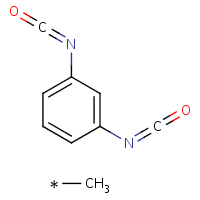Toluene diisocyanate
Agent Name
Toluene diisocyanate
Alternative Name
TDI
CAS Number
26471-62-5
Formula
C9-H6-N2-O2
Major Category
Plastics & Rubber

Synonyms
1,3-Diisocyanatomethylbenzene; 2,4/2,6-Toluene diisocyanate isomeric mixture; Benzene, 1,3-diisocyanatomethyl-; Diisocyanatotoluene; Isocyanic acid, methyl-m-phenylene ester; Methyl-m-phenylene isocyanate; Methyl-meta-phenylene diisocyanate; Methylphenylene isocyanate; Nacconate-100; Niax isocyanate TDI; Rubinate TDI; Rubinate TDI 80/20; TDI; TDI 80-20; Tolylene diisocyanate; Tolylene isocyanate; m-Tolylidene diisocyanate; 2,4- and 2,6-Toluene diisocyanate; Toluene-2,4-diisocyanate (mixt. With Toluene-2,6-diisocyanate); Toluenediisocyanate (mixed isomers); [ChemIDplus] VORANATE T-80 Type I TDI; [Dow Chemical MSDS] UN2068
Category
Diisocyanates
Description
Clear colorless to pale yellow liquid with a pungent odor; [HSDB] Colorless to yellow liquid with a sharp odor; mp = 14 deg C; [Dow Chemical MSDS]
Sources/Uses
Used to make polyurethanes, polyurethane foams, elastomers, and coatings, as a cross-linker for nylon-6, and hardener for adhesives and finishes; [HSDB]
Comments
Most commonly produced as a mixture of isomers, with 80% 2,4- and 20% 2,6-isomers; Also available as a mixture of 65% 2,4- and 35% 2,6-isomers; [HSDB] This CAS# is for mixture of toluene-2,4-diisocyanate and toluene-2,6-diisocyanate; Reacts slowly with water evolving carbon dioxide; An irritant; May cause skin and respiratory sensitization; Excessive inhalation exposure may cause severe irritation, pulmonary edema, permanently decreased lung function, neurologic disorders, cholinesterase depression, and gastrointestinal distress; [Dow Chemical MSDS] See "Medical Monitoring for Occupational Asthma Among Toluene Diisocyanate Production Workers in the United States." [PMID 29200134] See "Toluene-2,4-diisocyanate" and "Toluene 2,6-diisocyanate."
Biomedical References
Exposure Assessment
BEI
Toluene diamine in urine at end of shift = 5 ug/g creatine; [TLVs and BEIs]
Skin Designation (ACGIH)
Insufficient data
TLV (ACGIH)
0.001 ppm, inhalable fraction and vapor
STEL (ACGIH)
0.005 ppm, inhalable fraction and vapor
PEL (OSHA)
Ceiling(OSHA) = 0.02 ppm
Vapor Pressure
0.023 mm Hg
Odor Threshold Low
0.05 ppm
Lethal Concentration
LC50 (mouse) = 9.7 ppm/4hr
Explanatory Notes
No major toxicological differences between the various isomers and commercial mixtures of TDI; TLV Basis: asthma; pulmonary function; eye irritation; [ACGIH]
NFPA
must be preheated
Adverse Effects
Skin Sensitizer
Yes
Asthma
Yes
Toxic Pneumonitis
Yes
Fibrogenic
Yes
Dermatotoxin
Skin burns
IARC Carcinogen
Possible (2b)
NTP Carcinogen
Anticipated human carcinogen
Diseases, Processes, and Activities Linked to This Agent
Diseases
Occupational diseases associated with exposure to this agent:
Processes
Industrial Processes with risk of exposure: